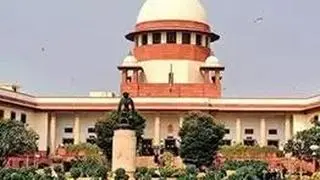While the Congress is opposing the Agnipath recruitment scheme for the Armed Forces, former Union Minister and party MP from Punjab Manish Tewari has endorsed it. Tewari is also among the G23 grouping which had raised the leadership issue in the Congress.
In a conversation with BusinessLine, Tewari explains why and how it should not be perceived as a move to switch sides towards the BJP.
Excerpts:
Are your reasons for supporting Agnipath political? Do you want to join the BJP?
There are two fundamental questions that need to be asked – the first is what is the current structure and recruitment policy of the Army and the second is what is going to be the impact of Agnipath recruitment scheme or the recruits, Agniveers… frankly, this terminology is too dramatic for me, but we’re talking on the substantive issues. So, what will be the impact of the new recruitment policy on the future of the Armed Forces. Reforms in militaries globally were initiated in the USA somewhere around 1975 when the Vietnam war ended. They began thinking conceptually about the future of Armed Forces because the nature of warfare had drastically changed. This process culminated in conceptualising the contours of the Armed Forces to have a lighter footprint, an expeditionary army, a more mobile army and so on. This is the template that has been followed across the world including in China which started the process in 1985. Since then, the Chinese have repeatedly right-sized the People Liberation Army (PLA). In an informationised environment where every domain being a battlefield including space, cyber space etc one is talking about contact-less warfare including drones etc., you require a very nimble and agile armed force which is technology-heavy and reliant on state-of-the-art weaponry.
In the Indian context, especially after the OROP got implemented, of every rupee spent on defence, 25 paise go towards pensions. About 64 per cent of the entire pension spend is only defence pensions. Every rupee that you’re spending on personnel, salary and pensions takes away from defence modernisation. This particular reform, the four-year Tour of Duty, has been under contemplation since the Kargil Review Committee, 1999 which recommended that the age profile of the armed forces should be brought down from 30 years at that time which has now gone up to 32 years. Subsequently, the Ramesh Chandra Committee set up by Dr Manmohan Singh’s government also endorsed these recommendations. The Navy and the Air Force are relatively smaller forces compared to the Army which is about 14-lakh strong from which about 60,000 people retire every year. In the next 10-year period, 6 lakh people would have retired which brings it down from 14 lakh to 8 lakh. In the intervening period, if you hire about 4.5 lakh, that would bring the force strength to 12.5 lakh. If the retirement process follows the four-year Tour of Duty structure in the intervening period, the size of the Army in the next ten years would come down from 14 lakh to 10.50 lakh which is the right-sizing that would take place owing to this reform. Attrition over these ten years is 3,52,500 people which is about 35,200 per year or about 2,933 a month. We have 10 Central Armed Police Forces and 36 State and UT police forces. What the government should have done is that they should have created a statutory/mandatory transition from the Agnipath into the CAPF and police forces. We’re just talking about 35,200 persons being absorbed per year which is less than 800 per police force. These are trained personnel that the forces will not have to expand upon. The good thing would be that once this transition happens, then they are looking at a permanent job with all the attendant benefits. So, overall, I don’t think this is a bad scheme at all.
You haven’t answered my question – are you joining the BJP?
This is a question I am asked every time I have a position which is at variance from what the party line is. Fortunately or unfortunately, I continue to be where I am. This is rather a non sequitur.
The government seems to have been caught unawares by the extent of anger against Agnipath?
The anger is symptomatic of the larger problem of unemployment that is confronting the country. Going back to the demonetisation to the November, 2016 there has been a series of mis-steps regarding the macro-economic management including the hastily implemented GST. Even before Covid-19, the economy was not in the best of shapes. There is general angst among the youth about the lack of opportunities. I have absolute empathy with that because this was a stable job opportunity. So if a transition was required from a strategic standpoint, you simultaneously need to augment the economy so that there are enough job opportunities available.
Why are you breaking ranks from the party on this crucial issue?
When I look at national security, I look at it from a non-partisan perspective. So, when I look at this entire shift in the recruitment paradigm and cognizant as I am of the conversations that have gone around this, to me personally it did not make any sense to oppose it in the manner it is being opposed. This is not a value judgement on anyone. There is nothing political in this.








Comments
Comments have to be in English, and in full sentences. They cannot be abusive or personal. Please abide by our community guidelines for posting your comments.
We have migrated to a new commenting platform. If you are already a registered user of TheHindu Businessline and logged in, you may continue to engage with our articles. If you do not have an account please register and login to post comments. Users can access their older comments by logging into their accounts on Vuukle.